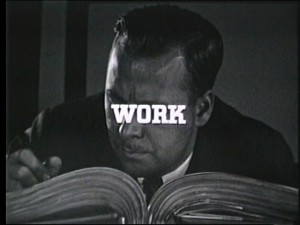
"Among the Ten Best, Another Day, by Leslie Thatcher, ACL, is a splendid example of the relatively simple avant garde film, so popular among European amateurs but so seldom attempted by even the advanced workers of the American continent. Set against the background of Toronto, Another Day portrays in semi abstract fashion the dramatic changes which overtake the life and tempo of a great city as Saturday crosses the noontime deadline from work to play. Mr. Thatcher's conception of this theme is clean cut, his execution suave and technically brilliant. Dissolves, wipeoffs and double exposure are blended intelligently with matchless straight photography to enhance the beauty of striking angles and compositions. With the subject matter of such films ready to the hand of every amateur cameraman, it is a strange phenomenon that to date they are not attempted more often." Movie Makers, Dec. 1934, 513, 534.

"Lindsay takes us on one of his family holidays into the mountain and lake areas. We are among the snow-capped hills, lush valleys, and many wild flowers, motoring and water-skiing on the lake" PSA Journal, Nov. 1960, 41.
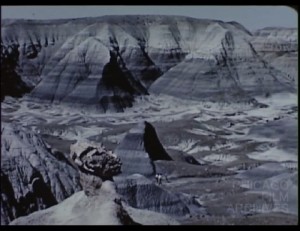
"A two-part lecture travelogue film on the state of Arizona. The film would have been originally presented with live narration by the filmmaker, Robert Davis. Part one includes footage of desert landscapes, ranches, pre-historic artifacts, Native American art production & industry (wigs, textiles, etc), saloons, regional industry (logging, agricultural, and dams). Part two also includes footage of desert landscapes, cacti and dams as well as scenes from Phoenix and the surrounding area. Highlights from part two include a tour of a trailer park and footage of people skiing and sledding down a snowy hill." Chicago Film Archives.

Travelogue that visits tourist destinations across several countries in South America.
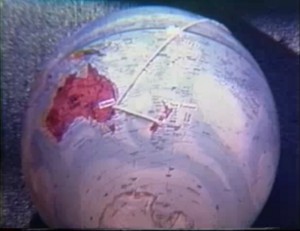
"In May-June 1988, Robbins Barstow and his wife Meg, of Wethersfield, Connecticut, USA, made a six-week trip around the world. Places visited include Hawaii, Austrailia, New Zealand, Singapore, Thailand, India, and London, England." Archive.org
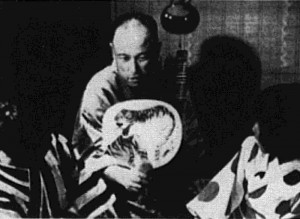
"A delightful bit of drama filmed by Kazuo Nakamura again illustrates that one does not have to travel far from his home to film a picture. This was filmed in Japan and one may assume that the maker had the cooperation of a local dramatic group. Mr. Nakamura has shown his skill and accomplishment in the finished product. It is a story within a story. The father tells his young son and daughter about the legend of the arrow which comes from nowhere to fall upon a roof. That home must sacrifice a daughter to some unknown person which in the story is a terrible old tiger. The animal, in the disguise of a man meets his fate at the hands of a god who disappears as mysteriously as he had appeared, while the villagers dance and celebrate their freedom. The children are now fast asleep. Although their native language is heard throughout, the story is easily followed. The costuming and acting are superb in their simplicity." PSA Journal, Nov. 1957, 32.

"Ralph E. Gray has once again turned his inquiring and sympathetic camera upon the people and places of Mexico. The result is Arts and Crafts in Mexico, an authentic and altogether admirable record of that country's hereditary handicrafts. Here, in almost lavish detail, is an intent family of woodworkers, fascinating in their casual skills with hands and feet. Here are senoritas who both weave and wear the lovely silken rebozo, which shares honors only with the serape as the mantle of Mexico. One sees with equal clarity and charm the fashioning of pottery, the firing of copper vessels and the fine crafting of Mexico's soft and gleaming silver. Even the great Diego Rivera, pictured at work in a sequence which is a genuine "'beat," is engagingly included within the family of Mexico's artisans. Mr. Gray has compiled a cinematic document of great beauty, genuine human interest and authentic social value." Movie Makers, Dec. 1945, 494.
"Col. Kelly took the time to use his camera effectively on an assignment in Korea where the older folks are referred to with family reverence as Papa-san and Mama-san. Here we have a review of life in Korea as an Army officer may see it. After the war there is reconstruction and training of the 4th largest standing army in the world. A country divided at the 38th parallel must live under the protection of a well-trained army, trained by U.S. personnel. A documentary-travelogue that lives all of its 25 minutes of screen time" PSA Journal, Nov. 1959, 47.
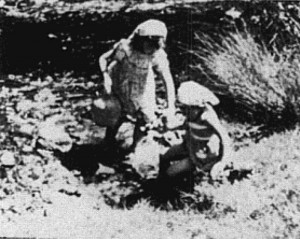
"Antonio Cernuda has created a pictorial mood, a feeling of being there, and a desire to live it again. His choice of music has contributed a great deal to this delightful picture. It begins in the early fall and we move quickly to the gathering of apples, processing, and the bottling of cider. There are celebrations of the gathering of the harvest, girls and boys in native Spanish dress, with the frolic of the occasion and the solemnity of the religious spirit. The first snow of winter, as the leaves are about gone, and on into the heavier snows and ice of winder as the people go about their daily travels—afoot, by horse-drawn vehicle, and train. The transition to spring is so skillfully set forth with the melting snow and turbulent streams that we are hardly aware of the passing of winter. Soon there is a burst of spring everywhere and then summer with its crops, vacation activities, boating, fishing, tug-of-war, and outdoor Mass. The picture opens and closes with artistic views of the mountainous country. We might think of this as the four seasons. Asturias, with its deep canyons and mountains, with scars of its heroic history, that have the darkness of coal in its womb, the whiteness of snow on its head, and the pink of apple blossoms on its body. Asturias lets her men go out into the world with the certainty that the homesickness for her beauty will always make them return." PSA Journal, Nov. 1957, 31.
"A compilation film documenting the many Augustas--streets, storefronts and cities from Montana to Maine--that Scott Nixon encountered as a traveling salesman based in Augusta, GA." Moving Image Research Collection, University of South Carolina
Total Pages: 37